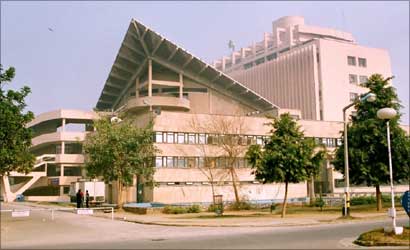 | « Back to article | Print this article |
Why India must create its own Bostons and Oxfords
Around the world, universities are the stuff that make great cities. Imagine Boston without Harvard, MIT (Massachusetts Institute of Technology), and the myriad other institutions that are clustered around the Boston-Cambridge area.
In Britain, Oxford and Cambridge are vibrant urban centres that derive their vigour almost entirely from playing host to famous universities.
Even large and diversified global cities like London and New York would be much diminished without the intellectual clustering of LSE (London School of Economics), Columbia, UCL (University College London) and NYU (New York University).
In each case, the universities are an integral part of the urban landscape and are consciously leveraged by their host cities.
Yet, Indian cities do not think of their universities and research institutes as important drivers of urban growth. At most, they are seen as utilitarian places for teaching students. Their importance for clustering human capital and driving innovation is simply not seen as part of overall urban strategy.
Indeed, universities built after Independence have been sealed off on campuses, often in distant locations, that deliberately discourage interaction with the wider city.
Thus, Kanpur and Kharagpur benefit little from being host to a prestigious institution like the IIT (Indian Institute of Technology). This is absurd.
Click on NEXT to read more...
Why India must create its own Bostons and Oxfords
The software of cities
Urban development is not just about the 'hardware' -- buildings, roads, plumbing and so on. It is the people, their social/economic activity and their continuous interaction that bring cities alive.
Successful cities are those that can cluster human capital and encourage innovation, creativity and exchange of ideas.
This has always been true. Think of the great cities of the past: Athens, Rome, Constantinople, Alexandria, Ujjain and Varanasi.
However, the this factor has become even more important in the 21st century. Never before has the economic value of ideation and creativity been greater. In short, the 'software' is critical to the evolution of a city.
Universities are key to the software of a city. They attract young talent, encourage the churn of ideas and trigger innovation.
The physical infrastructure of the university provides the venue for conferences, seminars and cultural/sporting events that allow for intense human interaction. Note how NYU played an important role in regenerating Lower Manhattan in the 90's.
Click on NEXT to read more...
Why India must create its own Bostons and Oxfords
Next generation global cities like Singapore recognise this dynamic and use it actively as part of urban/national economic strategy. For instance, Singapore has built out a number of new institutions like Singapore Management University over the last decade.
In most cases, these have been clustered in the middle of the city rather than on remote campuses. The city benefits from having a throughput of young people in the city-centre.
At the same time, the university benefits from easy access to industry, government and urban 'buzz'.
Prior to Independence, the urban role of universities was appreciated. The colleges of Bombay and Calcutta Universities were built into the city much like the colleges of London.
Even Delhi University, although built as a separate campus, was still seen as a part of the overall urban fabric. There were even important towns like Allahabad and Aligarh that were driven largely by their vibrant universities, much like Oxford and Cambridge.
Click on NEXT to read more...
Why India must create its own Bostons and Oxfords
Contrast this to how tertiary education institutions were built after Independence. All the IITs and IIMs are large, sealed campuses built originally outside the city.
The model was the industrial-era factory township. The physical walls that surround them have continued to wall them off socially and intellectually from their host cities even where urban growth has brought them inside the city.
How different from the urban campuses of MIT and Harvard Business School. This is a loss to both sides.
Perpetuating the mistake
We appear to have learned little from our past mistake. Indeed, this is not even considered an issue worthy of attention and debate.
Thus, the establishment of a new university or institute is still about acquiring large tracts of land, often hundreds of acres, and then building out stand-alone buildings.
If anything, success is measured by how much land has been acquired rather than the quality of education/research.
Click on NEXT to read more...
Why India must create its own Bostons and Oxfords
This is a very wasteful process at many levels. First, it is unnecessarily converting productive farm and forest land.
Why does Vedanta need 6,000 acres in Orissa and IIT Jodhpur 700 acres in Rajasthan for teaching a few thousand students?
Second, it requires the creation of expensive infrastructure in isolated locations, including staff housing, convocation halls, seminar rooms and so on. How many times a year is the convocation hall used by the institution itself?
In a city location, these facilities would have added to the overall urban infrastructure.
Third, such remote campuses are inconsiderate of the social, educational and career needs of the families of the faculty and staff. This is a major constraint to finding good faculty. We cannot build universities as if they are industrial-era factory townships where the wives stay at home and the children study in the company school.
Finally, and most damagingly, these campuses are unable to generate the externalities that one would associate with a good academic/research institute. Students come and leave. There is no clustering or inter-linkage with the real world.
Click on NEXT to read more...
Why India must create its own Bostons and Oxfords
The proposed IIT in Jodhpur is an example of how we are perpetuating the flawed model. The government has already acquired 700 acres of land about 22 km from Jodhpur.
There a lot of talk about how it will be a 'green' campus with solar panels and electric buses ferrying people from the city/airport. A number of complex options are being discussed to supply it with water. This is all meaningless when the most energy-efficient solution is to have had a compact campus that is nearer to the city.
This would have automatically reduced the need to travel long distances and recreate social infrastructure. In addition, Jodhpur city has a problem with rising water tables and there is absolutely no need for expensive water-supply technologies when it can simply be pumped out.
Worst of all, given the distance, the existing city will gain nothing from the creation of all the new and expensive infrastructure.
To conclude, universities are an important part of the urban economy and should be seen as an integral part of city-building.
As we build out new institutions, we urgently need to stop thinking of them as fenced-off factory townships. We do not need more Kanpurs and Kharagpurs. If India wants to play on the global stage, it needs to create its very own Bostons and Oxfords.
The author is president, Sustainable Planet Institute.






